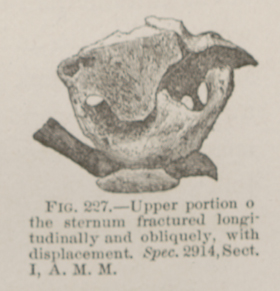Title: B——, H.
Source text: Surgeon General Joseph K. Barnes, United States Army, The Medical and Surgical History of the War of the Rebellion. (1861–65.), Part 1, Volume 2 (Washington, D.C.: Government Printing Office, 1870), 487.
Civil War Washington ID: med.d1e19397
TEI/XML: med.d1e19397.xml
CASE.—Private H. B——, 27th Michigan Volunteers, aged 21 years, was wounded at Spottsylvania, May 12th, 1864, by a fragment of shell, which contused the upper anterior portion of the chest without lesion of the integument. He was admitted to Fairfax Seminary Hospital on the 16th; there was a large tumor at the point of injury and extensive suggillation. Cold-water dressings were applied, and extra diet allowed. On the 17th, the tumor was evacuated by an incision, leaving a cavity some two inches in diameter. The patient did extremely well under the administration of quinia in small doses, and an extra diet, until June 15th, when there was anorexia, dry tongue, an apparently healthy discharge from the wound, troublesome cough, and muco-purulent sputum. To combat these symptoms, tonics, stimulants, and an extra diet were directed. The patient sank gradually, and, by July 5th, complained of great pain in the lower part of the abdomen. There was also difficulty in micturition, which lasted five days. On the 10th, there was difficulty in speaking; great dyspnœa; respiratory murmur around the wound, and pulse varying from 100 to 110. This was followed by coma, and the patient died on the 15th. The autopsy revealed a fracture of the sternum—small pieces of the manubrium being driven in—with two apertures in the bone communicating with the lung. There was a large abscess in the left lung, with evidences of extensive pleuritis and effusion in the pleural cavities. The remaining organs exhibited nothing worthy of remark. The pathological specimen is carious within to a considerable extent, and, on the internal surface, is partly covered with a plate of new deposit. It was contributed to the Army Medical Museum by Assistant Surgeon H. Allen, U. S. A., and is figured in the adjoining cut (FIG. 227).
